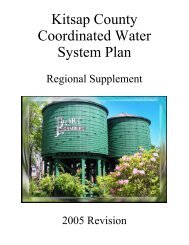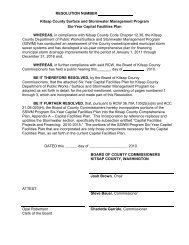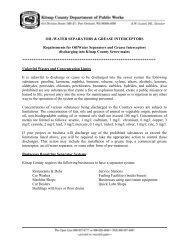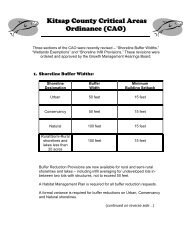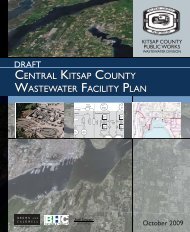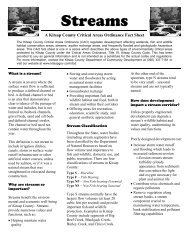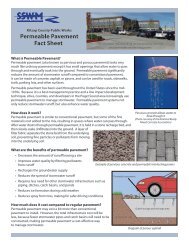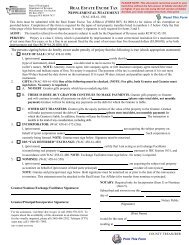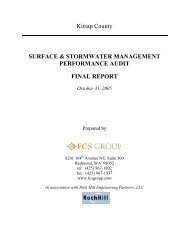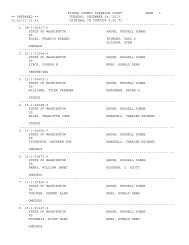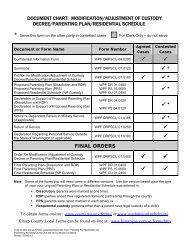Rain Garden Plants - Kitsap County Government
Rain Garden Plants - Kitsap County Government
Rain Garden Plants - Kitsap County Government
You also want an ePaper? Increase the reach of your titles
YUMPU automatically turns print PDFs into web optimized ePapers that Google loves.
<strong>Rain</strong> <strong>Garden</strong><br />
<strong>Plants</strong>:<br />
Purchase or<br />
Propagate?<br />
<strong>Rain</strong> gardens are beautiful<br />
landscape features built on<br />
developed property to mimic some<br />
of the functions of our native forests.<br />
<strong>Rain</strong> gardens are designed to allow<br />
stormwater runoff from roofs,<br />
driveways, walkways and other hard<br />
surfaces, to be absorbed back into<br />
the ground.<br />
Managing the speed and amount<br />
of water that flows into our drainage<br />
systems and waterways helps<br />
reduce flood events, adds to our<br />
groundwater supply (responsible for<br />
80 percent of our drinking water)<br />
and treats some forms of pollution.<br />
The planted surface of the rain<br />
garden can be an attractive landscape<br />
feature, while providing a welcoming<br />
habitat for wildlife — all in your<br />
own yard!<br />
As the population of the Puget<br />
Sound basin continues to grow,<br />
we must find ways to manage the<br />
impacts of growth while keeping<br />
our natural systems healthy. <strong>Rain</strong><br />
gardens are an attractive way to<br />
reintroduce natural functions<br />
into the developed environment.<br />
A step-by-step guide to building<br />
a rain garden is available at your<br />
Washington State University<br />
<strong>County</strong> Extension office or online<br />
at www.pierce.wsu.edu/Water_<br />
Quality/LID/.<br />
This pamphlet summarizes where<br />
you can obtain native plants<br />
for a rain garden and how you<br />
can propagate your own plants.<br />
Although the emphasis is on native<br />
plants, you can find drought-tolerant<br />
cultivars that are also suitable in a<br />
rain garden.
How to “Make” Your Own <strong>Plants</strong><br />
Hardwood and<br />
Softwood Cuttings<br />
Step 1: Using a clean,<br />
sharp pair of scissors,<br />
clip off a young,<br />
straight, pencil-sized<br />
part of an existing<br />
plant, directly above<br />
a leaf node and at an<br />
angle, when the plant<br />
is dormant.<br />
Hardwood And Softwood<br />
Cuttings<br />
Step 2: Prepare the soil (in the ground or a<br />
pot) by moistening it and poking a hole for<br />
the cutting to go in. You may want to add<br />
vermiculite, perlite or well-composted sawdust<br />
to retain water and keep the soil loose.<br />
Step 3: Dip the end of the cutting in a rooting<br />
hormone (See next page for recommended<br />
rooting hormone recipe).<br />
Step 4: Place the cutting in the soil and push in<br />
the soil to support the cutting.<br />
Live Stakes<br />
Step 1: Follow the directions for hardwood<br />
cuttings but plant the stakes outdoors. Rooting<br />
hormone is not necessary.<br />
Step 2: Make sure the soil is wet or drive<br />
the stake in far enough so that the end meets<br />
moisture.<br />
Step 3: Leave the top two nodes above the<br />
ground and plenty of space around it for the<br />
roots to grow.<br />
Dividing <strong>Plants</strong><br />
Step 1: Dig up the entire<br />
plant, roots included,<br />
when it is dormant.<br />
Step 2: Using your<br />
hands or a sharp knife,<br />
gently divide the crown<br />
and root ball into two<br />
(or more) parts.<br />
Dividing <strong>Plants</strong><br />
Step 3: Replant each part (in the ground or in<br />
a pot) and water thoroughly.<br />
<strong>Plants</strong>-at-a-Glance!<br />
Plant Name Propogation Method Zone Sun / Shade / Partial (P) Plant Type<br />
Black twinberry (Lonicera involucrata) hardwood cuttings/live stakes/layering 1 sun / P deciduous shrub<br />
Clustered wild rose (Rosa pisocarpa) transplanting suckers 2 (or 1) sun / P deciduous shrub<br />
Coastal strawberry (Fragaria chiloensis) transplanting suckers 3 sun / P evergreen groundcover<br />
Common snowberry (Symphoricarpos albus) hardwood cuttings/transplanting suckers 3 (or 2) sun / P deciduous shrub<br />
Creeping raspberry (Rubus pedatus) hardwood cuttings/live stakes 3 sun / shade evergreen groundcover<br />
Deer fern (Blechnum spicant) division 1 P / shade short evergreen perennial<br />
Elderberries (Sambucus species) layering 2 (or 3) sun / P deciduous shrub<br />
Hardstem bulrush (Scirpus acutus) division 1 sun / P tall deciduous perennial<br />
Hazelnut (Corylus cornuta) transplanting suckers 2 (or 3) sun / P deciduous shrub<br />
Lady fern (Athyrium filix-femina) division 1 P / shade short evergreen perennial<br />
Mock-orange (Philadelphus lewisii) hardwood cuttings/transplanting suckers 3 sun / P deciduous shrub<br />
Oceanspray (Holodiscus discolor) hardwood cuttings 3 sun / P deciduous shrub<br />
Osoberry/Indian-Plum (Oemleria cerasiformis) cuttings/layering/seed 2 P deciduous shrub<br />
Pacific ninebark (Physocarpus capitatus) hardwood cuttings/live stakes 1 sun / P deciduous shrub<br />
Red-flowering currant (Ribes sanguineum) hardwood cuttings/layering 3 sun / P deciduous shrub<br />
Red huckleberry (Vaccinium parvifolium) layering 2 (or 3) P / shade deciduous shrub<br />
Red-osier dogwood (Cornus sericea) hardwood cuttings/live stakes/layering 1 sun / P deciduous shrub<br />
Rushes (Juncus species) division 1 sun / P tall grass-like perennial<br />
Salmonberry (Rubus spectabilis) hardwood cuttings/live stakes/transplanting suckers 2 (or 1) P / shade deciduous shrub<br />
Sedges (Carex species) division 1 sun / P tall grass like perennial<br />
Small-fruit bulrush (Scirpus microcarpus) division 1 sun / shade tall deciduous perennial<br />
Spirea (Spiraea douglasii) hardwood cuttings 1 sun / P deciduous shrub<br />
Sword fern (Polystichum munitum) division 1 P / shade short evergreen perennial<br />
Thimbleberry (Rubus parviflorus) hardwood cuttings 2 sun / P deciduous shrub<br />
Vine maple (Acer circinatum) layering 1 P / shade deciduous tree<br />
Willows (Salix species) live stakes/layering 1 sun / P deciduous shrub
Layering<br />
Layering<br />
Step 1: Bend a lowlying<br />
branch of an<br />
established plant into<br />
a “U” shape so that<br />
you can bury the<br />
bottom of the “U” in<br />
the ground.<br />
Step 2: With a sharp<br />
knife or scissors, make small cracks in the<br />
bottom of the “U’.<br />
Step 3: Stake down the still-connected “U”<br />
branch in three to six inches of soil. The new<br />
plant will be ready in six to12 months.<br />
Transplanting Suckers<br />
(sometimes called runners)<br />
Suckers are young<br />
plants that sprout<br />
horizontally from<br />
the roots of a parent<br />
plant.<br />
Step 1: From an<br />
already established<br />
plant, dig up<br />
Transplanting Suckers<br />
enough root to<br />
separate the sucker<br />
from the parent plant. Be sure the sucker<br />
plant has sufficient roots to survive on its<br />
own and keep the roots encased in soil.<br />
Step 2: With a sharp knife, shovel or pruner,<br />
separate the root connecting the sucker.<br />
Step 3: Replant the sucker in the ground or<br />
in a pot.<br />
Make your own<br />
rooting hormone<br />
— it’s as easy as<br />
making tea:<br />
In a cooking pot, submerge<br />
willow clippings (either the<br />
bark or the yellow tip) in water.<br />
Allow to sit on low heat, not<br />
boiling, for two hours.<br />
Turn off heat and let the “tea”<br />
sit for 12 hours.<br />
After the tea has cooled, strain<br />
the willow and it’s ready to use.<br />
Unused rooting hormone can<br />
be stored in the refrigerator and<br />
used for years!<br />
Illustrations based on drawings by Kevin Svara, published by WSU Extension - Thurston <strong>County</strong>.<br />
Flower/Fruits/Foliage<br />
Maximum Height<br />
small red flowers/dark purple berries 9ft (3m)<br />
medium pink flowers<br />
6ft (2m)<br />
dark green foliage/red fruit<br />
10in (25.5 cm)<br />
small pink flowers/white berries 3ft (1m)<br />
small white flowers/red berries<br />
Great Peninsula Nurseries for Native <strong>Plants</strong><br />
Plant Sales<br />
Bainbridge <strong>Garden</strong>s<br />
9415 Miller Road NE<br />
Bainbridge Island, WA<br />
98110-0176<br />
206.842.5888<br />
www.bainbridgegardens.<br />
com<br />
Bremerton City Nursery<br />
912 Adele Avenue<br />
Bremerton, WA 98312<br />
360.373.8765<br />
www.bremertoncity<br />
nursery.com<br />
Clear Creek Nursery<br />
11688 Clear Creek Road<br />
NW<br />
Silverdale, WA 98383<br />
360.308.8210<br />
www.clearcreeknursery.net<br />
Dragonfly Farms & Nursery<br />
34881 Hansville Road<br />
Kingston, WA 98346<br />
360.638.1292<br />
www.dragonflyfarms<br />
nursery.com<br />
Open March through<br />
November<br />
Fri and Sat 9 a.m. to 5 p.m.<br />
Sun 9 a.m. to 4 p.m.<br />
Other times and seasons by<br />
appointment only<br />
Fir Run Nursery<br />
15102 91st Ave Ct. E<br />
Puyallup, WA 98375<br />
253.848.4731<br />
www.firrunnursery.com<br />
Friendly Natives <strong>Plants</strong> &<br />
Design<br />
2105 Country View Lane<br />
NE<br />
Bainbridge Island, WA<br />
98110<br />
206.387.5943<br />
www.friendlynatives.com<br />
Foxglove Greenhouse<br />
30600 Hansville Rd NE<br />
Kingston, WA 98346<br />
360.297.0410<br />
By appointment only<br />
Glenwood <strong>Garden</strong>s<br />
15155 Glenwood Road SW<br />
Port Orchard, WA 98367<br />
360.876.2449<br />
Wed-Friday<br />
10 a.m. to 6 p.m.<br />
By appointment only<br />
Gig Harbor Farmer’s<br />
Market Saturdays<br />
Inside Passage Seeds<br />
PO Box 639<br />
Port Townsend, WA 98364<br />
800.361.9657<br />
www.insidepassageseeds.<br />
com<br />
Randy’s Nursery/Randy &<br />
Debbie Raub<br />
12081 Bethel Burley Rd SE<br />
Port Orchard, Wa 98367<br />
Port Orchard and Gig<br />
Harbor Farmer’s Markets<br />
April-November<br />
360.895.4307<br />
Roadhouse Nursery<br />
12511 Central Valley Road<br />
NW<br />
Poulsbo, WA 98370-7016<br />
360.779.9589<br />
www.roadhousenursery.<br />
com<br />
Rodgers Country Nursery &<br />
<strong>Garden</strong>s<br />
2075 Seabeck Highway<br />
NW<br />
Bremerton, WA<br />
360.478.0288<br />
Rosedale <strong>Garden</strong>s<br />
7311 Rosedale Street NW<br />
Gig Harbor, WA 98335<br />
253.851.7333<br />
www.rosedalegardens.com<br />
Savage <strong>Plants</strong><br />
6810 NE State Highway<br />
104<br />
Kingston, WA<br />
360.297.8711<br />
Sundquist Nursery<br />
3809 NE Sawdust Hill<br />
Road<br />
Poulsbo, WA 98370<br />
360.779.6343<br />
Public Open <strong>Garden</strong>s:<br />
9:30 a.m. to 3:30 p.m.<br />
www.sqnursery.com<br />
Treez Inc.<br />
Jim Trainer<br />
360.792.2449<br />
By appointment only<br />
www.treezinc.com<br />
Valley Nursery<br />
20882 Bond Road NE<br />
Poulsbo, WA 98370<br />
360.779.3806<br />
www.valleynurseryinc.com<br />
Woodbrook Nursery<br />
5919 78th Avenue NW<br />
Gig Harbor, WA 98335<br />
253.265.6271<br />
Fri and Sat 10 a.m. to<br />
4 p.m.<br />
Tue, Wed, Thurs by<br />
appointment only<br />
Yang’s Nursery<br />
5180 Country Club Way<br />
SE<br />
Port Orchard, WA<br />
360.871.3555<br />
www.yangsgarden.com<br />
<strong>Kitsap</strong> <strong>County</strong><br />
Conversation District-<br />
1032 Central Valley Rd NE.<br />
360.337.7171<br />
www.kitsaped.org<br />
The “Tree Sale” is held in<br />
March. Orders must be in<br />
by late January.<br />
Thanks to the following people who assisted in the creation of this document: Christine<br />
Coltellaro (author), University of Washington (UW) intern • Jeff Adams (co-author),<br />
Washington Sea Grant (WSG) • Peg Tillery (contributor), Washington State University (WSU)<br />
<strong>Kitsap</strong> <strong>County</strong> Extension • Sara Stansfield (contributor), UW intern • David G. Gordon<br />
(editor), WSG • Robyn Ricks (designer), WSG • Erica Guttman, WSU Thurston <strong>County</strong><br />
Extension • Curtis Hinman, WSU Pierce <strong>County</strong> Extension • Jayna Ericson, <strong>Kitsap</strong> <strong>County</strong><br />
Surface and Stormwater Management Program<br />
More information on rain gardens and low-impact<br />
development practices is available from Washington<br />
State University Extension, pierce.wsu.edu, Stewardship<br />
Partners, stewardshippartners.org, or the Puget Sound<br />
Partnership, psp.wa.gov.<br />
References<br />
Kruckeberg, Arthur R. 1992. <strong>Garden</strong>ing with Native<br />
<strong>Plants</strong> of the Pacific Northwest<br />
University of Washington Press, Seattle, WA. ISBN<br />
0-295-96853-2<br />
Native Plant Guide for King <strong>County</strong><br />
green.kingcounty.gov/GoNative/Index.aspx<br />
<strong>Rain</strong> <strong>Garden</strong> Handbook for Western Washington<br />
Homeowners<br />
pierce.wsu.edu/Water_Quality/LID/<strong>Rain</strong>garden_<br />
introduction.pdf<br />
Composting References<br />
<strong>Kitsap</strong> <strong>County</strong> Public Works Solid Waste Division<br />
kitsapgov.com/sw<br />
360.337.5557<br />
Mastercomposter Web Site<br />
mastercomposter.com<br />
This brochure is funded with a Washington State Department of Ecology grant.



